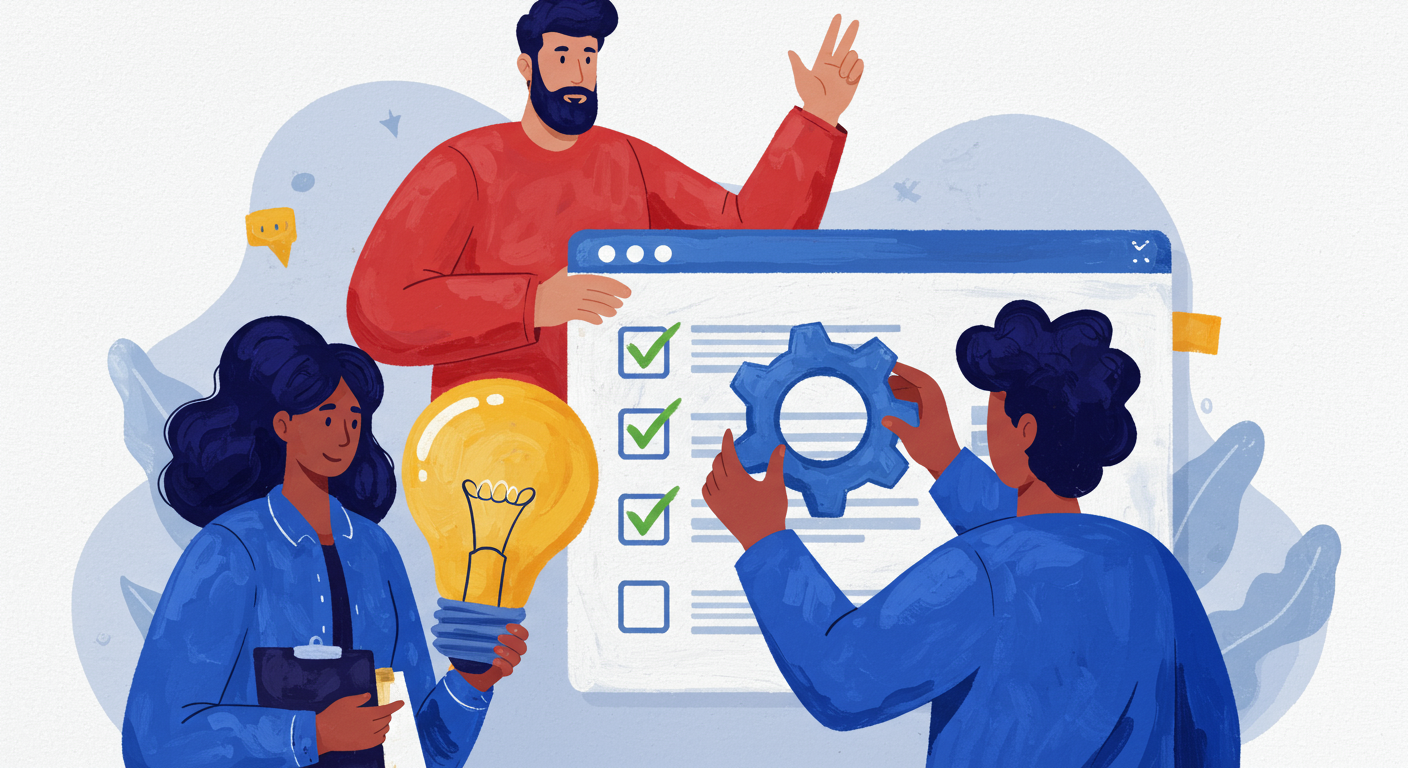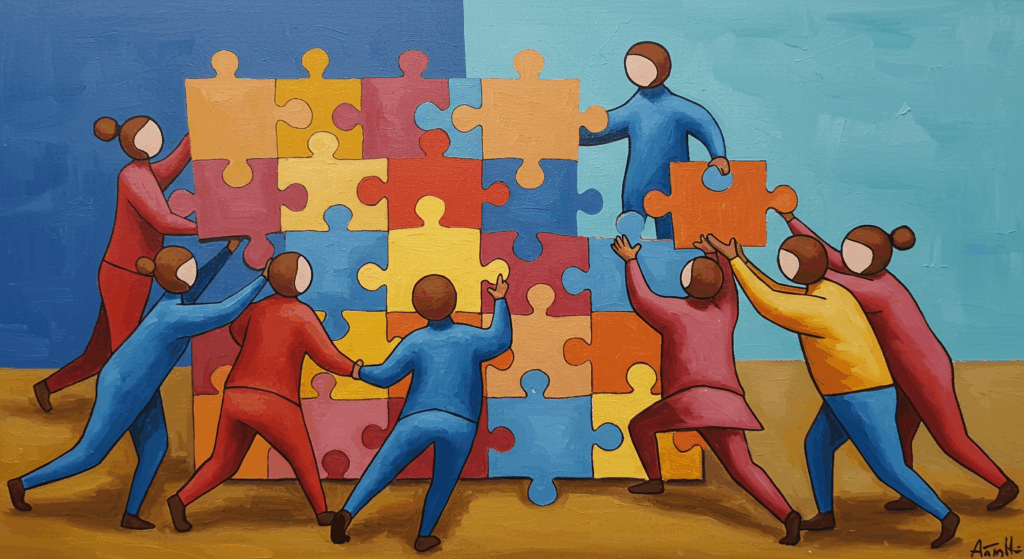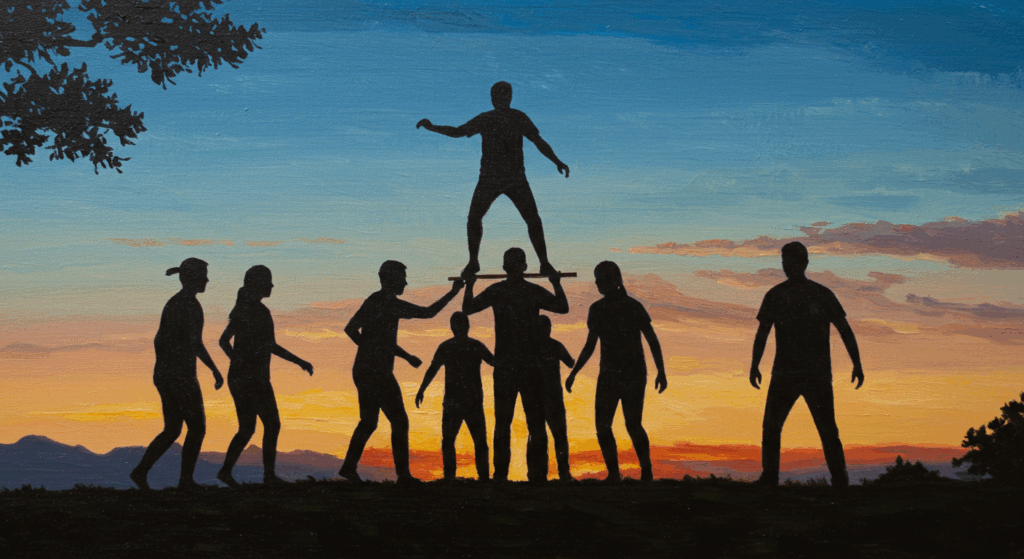If you’ve ever tried to cook a full dinner with roommates—someone chopping onions, someone burning the garlic (it’s always the garlic), someone asking where the salt is for the tenth time—you already know the core truth about teamwork: it’s messy, funny, occasionally chaotic, and somehow the food still tastes better when you made it together. That’s kind of the vibe at work, too. Teamwork isn’t just a corporate buzzword your HR portal throws around; it’s how stuff gets done without your brain melting into a puddle on your keyboard.
So let’s talk about it like real people. No stiff lecture. Just practical, slightly imperfect advice on how modern teams actually function, how to build collaboration, group synergy, effective communication (yep, we’ll unpack those), and what to do when your project feels like a group chat with 87 unread messages and zero decisions. Grab a snack. And maybe some water. Hydration = clarity, fr.
Why Teamwork Still Matters (Even If You’re a Lone-Wolf Coder at Heart)
There’s this temptation to be the solo hero—like, “I’ll fix the spreadsheet myself,” or “I’ll rewrite the API because it’s faster if I just do it.” Sometimes that works. But most real-world problems aren’t solo speedruns; they’re co-op games. Teamwork matters because:
- You get more perspectives (and fewer blind spots).
- Work moves parallel, not just serial—things ship sooner.
- People catch your typos, wild assumptions, and “I thought we agreed?” moments.
- Energy multiplies. When someone’s excited, it kind of leaks into the room (in a good way).
And tbh, our world is so cross-functional now—design + engineering + marketing + ops + finance + that one person who “knows the vendor”—you literally can’t dodge teamwork without limiting your impact.
The Three Pillars: Collaboration, Group Synergy, Effective Communication
You’ll see these words everywhere, but they’re more than LinkedIn hashtags.
Collaboration: Doing the Work Together (Not Side-by-Side and Silent)
Collaboration is not just sharing a Google Doc and hoping for the best. It’s deliberately aligning on goals, splitting responsibilities sensibly, and cecking in just enough to stay in sync without micromanaging. Great collaboration feels like a dance—you’re aware of each other’s moves, you trust the rhythm, and nobody’s stepping on toes (okay, not too much).
Group Synergy: When 1 + 1 Somehow = 3
“Group synergy” is that extra something—the creative sparks, the surprising angles, the way one person’s half-idea becomes another person’s killer feature. You can’t force it, but you can set the conditions: psychological safety, diversity of thinking, and a structure that lets people riff without fear of being shut down.
Effective Communication: Say It Clean, Say It Kind, Say It Soon
“Effective communication” is sharing context early, asking clarifying questions, and choosing the right channel (Slack for quick, docs for decisions, calls when emotions or ambiguity are high). It’s also saying the quiet part out loud—expectations, risks, blockers—before they bite.
A Casual Map of How Teams Actually Work (Not Just in Theory)
You can imagine a healthy team journey in five loose phases. This isn’t a rigid framework; it’s the “vibes chart” of real teamwork.
1) Getting Oriented: The “Wait, What Are We Doing?” Phase
- Clarify the goal in plain language: “We’re launching a basic v1 landing page by October 15 with email capture and a demo video.”
- Define success metrics that are human-understandable.
- Decide who’s the DRI (Directly Responsible Individual). Yes, one person. Decision by committee = chaos.
2) Setting Roles Without Crushing People
- Who owns what? Be specific: “Dev owns API + integrations, Design owns hero section + mobile layout, Growth owns copy + email flow.”
- Document interdependencies (what blocks what).
- Make “help requests” normal. A quick “I’m stuck; can someone pair with me?” should feel safe.
3) Building the Rhythm: Rituals You’ll Actually Keep
- Short daily async check-ins: 2–3 bullets max (done/doing/blocked).
- Weekly review: What shipped, what slipped, what we learned.
- Monthly retro: “What felt good? What needs a fix? What do we stop/continue/start?” Keep it nice but real.
4) Handling Conflict Before It Melts the Group Chat
- Use “disagree and commit” when you’ve debated enough.
- Separate ideas from identity: “I’m pushing back on the approach, not on you.”
- Press pause when emotions spike. A five-minute break can save five days of resentment.
5) Closing the Loop: Celebrate and Document
- Ship, celebrate, and reflect. Even a quick “what would we do differently?” makes your next cycle faster.
- Save the receipts: links, decisions, and final artifacts in one doc. Future-you will love you.
Practical Ways to Strengthen Collaboration, Group Synergy, Effective Communication (the remix)
Make Your Work Visible
- Shared roadmap with status tags: “Planned / In Progress / In Review / Shipped.”
- Track decisions in a living doc: date, decision, owner, reasoning.
- If it’s not written down, it’s not real. (I know, I know—writing’s annoying. But it’s the only way distributed teams remember.)
Write Messages People Can Read in One Coffee Sip
- Start with the headline: “Decision needed by EOD: choose email provider (A vs. B).”
- Put the TL;DR at the top. Dwtails below for the nerds (me, I’m the nerd).
- Ask explicit questions. “Can you review this before 3pm and flag any red-lines?”
Normalize Feedback as a Gift (Not a Drive-By)
- Use the “SBI” pattern: Situation, Behavior, Impact.
- Add a “+1” or “thanks” message when someone helps you. Gratitude is free, and it multiplies synergy.
- Keep praise specific. “Nice job” is nice. “The way you clarified the error states saved us hours” is motivating.
Meetings That Don’t Make People Hate Meetings
- Default to asynchronous; escalate to a call only when needed.
- If you do meet: clear agenda, timebox everything, and record the decisions.
- End with “next steps, owners, deadlines.” Otherwise expect 🙃.
Calm the Tool Sprawl
Pick a tool for each job and stick with it. For example:
- Slack/Teams for chat & quick questions
- Docs/Notion/Confluence for decisions and specs
- Jira/Trello/Linear for tasks
- Figma/Whimsical for design & flows
You don’t need five whiteboard tools. Honestly.
The People Side (a.k.a. The Part Nobody Teaches You Enough)
Psychological Safety Is the On/Off Switch for Group Synergy
If people worry about looking dumb, they won’t share weird ideas, and weird ideas are often the good ones. Create safety by:
- Admitting your own uncertainties first. “I’m not sure if this will scale, help me think it through?”
- Asking quieter folks directly: “Sam, what’s your take? We haven’t heard your angle yet.”
- Reacting to mistakes with curiosity, not blame. (We can do a blameless postmortem and still learn.)
Diversity of Thinking Is a Feature, Not a Bug
Backgrounds, skills, cultures, neurotypes—mixing them well improves collaboration. Synergy comes from friction that’s managed, not avoided. If you only work with people who think like you, you’ll move fast and miss the turn.
Boundaries Make Teams Sustainable (and Like… Happy)
- Set Slack expectations (e.g., no late pings unless truly urgent).
- Use status messages (“deep work,” “heads down,” “school pickup”) so folks know when to expect replies.
- Respect vacations. If you “soft work” through PTO, you teach the team that rest is fake.
Communication Techniques That Actually Work (and won’t make you sound like a robot)
The 30-Second Context Rule
Before you ask anything, add two lines of context:
- What we’re doing
- Why it matters
Then the question. It reduces back-and-forth. Magic.
The “What Good Looks Like” Snapshot
When you assign a task, include a mini-preview of success: “A good outcome is a one-pager that compares three options, notes cost/complexity/risks, and recommends one.”
The “Am I Missing Anything?” Check
End proposals with “What are we not seeing?” You’d be amazed how often the quiet genius in the corner drops a gem.
Handling Common Team Problems Without Drama
1. Problem: The Perpetual Over-Talker
- Use a round-robin so Everyone shares for 60–90 seconds.
- Set timeboxes for each topic.
- If you’re the over-talker (hi, it me sometimes): write your ideas before the meeting; keep your live share to the highlights.
2. Problem: Decision Paralysis (aka Endless Debates)
- Choose a decision framework: majority vote, DRI decides, or “disagree and commit.”
- Set a decision deadline. If the clock hits zero, the DRI picks and we move.
3. Problem: Silent Meetings
- Send a pre-read. Require comments before the call.
- Call on people intentionally (but kindly).
- Try a written brainstorm for five minutes before speaking.
4. Problem: “Wait, Who Owns This?”
- Use one owner per task. Shared ownership often means nobody actually owns it.
- Keep a public “RACI”-ish list (Responsible, Accountable, Consulted, Informed) for big projects.
5. Problem: “We Shipped It… But Nobody Adopted It”
- Involve stakeholders early: design partners, beta testers and ,..that one sales rep who sees everything.
- Roll out with training, not just announcements.
- Measure adoption, not just delivery. Shipping isn’t the finish line; using is.
Remote, Hybrid, Office: Making It Work Wherever You Are
Remote Tips (so your laptop doesn’t become your entire personality)
- Over-communicate decisions in writing.
- Use “working with me” docs: preferred channels, hours, pet peeves (e.g., “please avoid tagging me in 12 threads for the same issue”).
- Create casual touchpoints: quarterly offsites or virtual coffees. Silly games are allowed. Trivia about each other’s pets is practically required.
Hybrid Tips (the “best of both worlds” if you do it right)
- Be remote-first even if some people are in the office. But, don’t make decisions in hallways.
- If it happens in person, recap it online.
- Anchor in-office days around collaboration (whiteboarding, feedback jams), not solo work.
In-Office Tips (remember commutes? same.)
- Batch meetings to make the commute worth it.
- Protect focus blocks. Open office ≠ open season for interruptions.
- Keep docs digital so remote teammates aren’t left behind.
Culture Codes That Support Collaboration, Group Synergy, Effective Communication
These are like house rules—simple, repeatable, and surprisingly powerful.
- Default to kindness. Assume positive intent until proven otherwise.
- Document decisions. Memory is cute; docs are reliable.
- Own outcomes, not just tasks. If your piece is done but the project isn’t, you’re not done.
- No “gotcha” moments. If something looks off, ask early in private before blasting it in a big channel.
- Celebrate learning. Share “what didn’t work and why.” Yes, the team memes are encouraged.
The Quiet Superpowers of Great Teams
Clear Priorities (No, You Can’t Have 11 #1s)
Pick three priorities max. When everything is “critical,” nothing is.
Cadence (Small, Steady, Ship)
Short cycles with small wins build trust. People believe in teams that finish things.
Language (Words Shape Reality, wow that sounds deep)
Say “we” a lot. Use words like experiment, prototype, iteration. It lowers the stakes and boosts creativity.
Time Horizons (Now, Next, Later)
- Now: 1–2 weeks
- Next: 1–2 months
- Later: parking lot with occasional review
This keeps teams from doom-planning the next five years while forgetting the bug that’s crashing prod.
Collaboration, Group Synergy, Effective Communication in Action (Mini Scenarios)
1: The Product Launch Crunch
- Collaboration: Engineering pairs daily, Design posts one mid-week check, Marketing drafts the announcement early.
- Group Synergy: QA notices a UX issue nobody saw; Sales shares customer phrasing that upgrades your messaging.
- Effective Communication: One doc tracks the launch checklist and the single source of truth. Decisions are bolded at the top.
2: The “Uh-Oh” Postmortem
- Collaboration: No blame; just data, timeline, and recovery plan.
- Group Synergy: The fix sparks an idea for a new monitoring dashboard.
- Effective Communication: The incident recap is clear, short, and focused on prevention.
3: Cross-Functional Experiment
- Collaboration: Growth, Product, and Support team up to test a new onboarding flow.
- Group Synergy: Support insights reshape copy, dev prototypes a clever modal, and Growth finds a no-code tool to test fast.
- Effective Communication: Weekly update posts with learnings—win or lose—so the whole org actually, you know, learns.
Leadership in Teamwork (Even If You’re Not a Manager)
Leadership isn’t a job title; it’s a behavior set:
- Clarity: “Here’s the target, here’s why, here’s how we’ll know.”
- Courage: “I’ll make the call and take the heat if needed.”
- Care: “How are you doing, really?”
- Consistency: Show up steady. If your vibes swing like a crypto chart, the team can’t calibrate.
Pro tip: If you want more influence, own the unsexy parts. Close loops. Write recaps. Run clean meetings. People start to rely on you, and trust is basically the currency of all collaboration.
How to Build Momentum When Things Are… Meh
We’ve all been in that sludge phase where everything is a little late and nobody wants to be the first penguin into the water. Try:
- A tiny, guaranteed win. Ship a small feature, fix a papercut bug, or clean a gnarly dashboard.
- A “burst” session. 45 minutes of focused pairing with screenshare.
- A reset ritual. New weekly cadence, fresh agenda, two priorities max.
- Re-articulate the why. People sprint harder when the purpose is crisp.
Pitfalls to Avoid (No judgment, we’ve all done these)
- Over-optimizing process. If your template needs a template, you’ve gone too far.
- Under-communicating change. People hate surprises unless it’s cake.
- Overloading the “top performers.” Burnout nukes synergy. Share the load.
- Ignoring interpersonal friction. If two folks won’t collaborate, your project will silently pay the price. Step in early.
Tiny Team Rituals That Make a Big Difference
- “Demo Fridays.” Show anything you finished, no matter how small.
- “Gratitude thread.” Shout-outs in a channel. Keep it rolling.
- “Decision digest.” Weekly post of what changed and why.
- “No-meeting mornings.” Give brains a chance to do deep work.
- “Focus sprints.” 90 minutes of cameras-on, mics-off, lo-fi beats ft. that chill crab on YouTube.
Using Tech Without Letting It Use You
Tools can help or harm. A quick guide:
- Notifications: Mute aggressively. Create filters for urgent vs. FYI.
- Channels: Name them clearly; archive dead ones.
- Docs: Start messy, refine as you go, add a table of contents later.
- Versioning: Keep the “source of truth” obvious, so five copies don’t argue.
Bringing It All Together (Because You’ve Got Stuff to Do)
Let’s land this plane. Teamwork—real, useful teamwork—comes down to a few habits done consistently:
- Define the goal in plain English.
- Assign one owner per decision.
- Keep collaboration, group synergy, effective communication front and center through clear writing, conscious meetings, and psychological safety.
- Start small, ship often, document decisions, celebrate wins.
- Be kind. Seriously. You can be direct and still be kind.
We’re not aiming for cinematic perfection here. Real teams are a little messy. People have off days. Someone forgets to unmute. Someone else writes a Slack novel at 11pm (pls don’t). But with the right rhythms and a shared commitment to clarity and care, teams do incredible things. The kind of things you look back on and go, “Wow, we built that. Together.”
Quick Starter Kit (Bookmark This in Your Brain)
- Kickoff: One-page brief with goals, success metrics, roles, risks.
- Cadence: Async daily updates + weekly review + monthly retro.
- Decisions: Log them in a doc. One owner per decision.
- Communication: TL;DR first. Ask clear questions. Write like a human.
- Culture: Praise specifically. Normalize help requests. Protect focus time.
- Recovery: When things wobble, pick one tiny win and ship it.
Alright, that’s the talk. Now go nudge your team toward one small improvement—rewrite a fuzzy task, set up a quick retro, or drop a thank-you to that teammate who saved your Tuesday. And hey, if this helped, share it with your crew so the collaboration, group synergy, effective communication glow spreads a little wider.
You got this. Let’s build cool things together—one honest convo, one clean doc, one small ship at a time.









